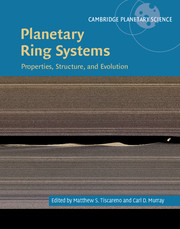Book contents
- Frontmatter
- Contents
- List of Contributors
- Acknowledgements
- I Introductory Material
- II Ring Systems by Location
- III Ring Systems by Type and Topic
- IV Concluding Material
- 19 Future Missions to Planetary Rings
- 20 Planetary Rings and Other Astrophysical Disks
- 21 The Future of Planetary Rings Studies
- Index
- Plate section
- References
19 - Future Missions to Planetary Rings
from IV - Concluding Material
Published online by Cambridge University Press: 26 February 2018
- Frontmatter
- Contents
- List of Contributors
- Acknowledgements
- I Introductory Material
- II Ring Systems by Location
- III Ring Systems by Type and Topic
- IV Concluding Material
- 19 Future Missions to Planetary Rings
- 20 Planetary Rings and Other Astrophysical Disks
- 21 The Future of Planetary Rings Studies
- Index
- Plate section
- References
Summary
USEFUL OBSERVATIONS AND INSTRUMENTATION
It is only natural for ring scientists to look to space flight missions to acquire more and better data about rings: every significant improvement in the resolution of ring data has brought to light new ring phenomena and expanded our understanding of these complex systems. Ground-based and Earth-orbiting space-based instruments still make useful contributions, but after the Voyager, Galileo, and Cassini-Huygens missions, observations from the vicinity of the rings are needed to provide further improvement in resolution. For example, imaging with both the spatial and temporal resolutions to track individual ring particles and their interactions will not be done by near-Earth instruments, or even spacecraft in Cassini-like orbits; close proximity observations are required.
A variety of different observation types, from a wide range of distances, promise groundbreaking ring science at multiple solar system destinations. Visible imaging provides information about ring structure and dynamics, and, in some cases, sizes of the largest particles or agglomerations. Spectral data from multicolor visible imaging can provide some information about compositional variability. Ultraviolet and infrared spectral data, especially from imaging spectrometers, are particularly useful for composition determinations, and are also useful for ring structure, particle surface texture, and particle size and rotation investigations. Stellar and solar occultations can measure detailed ring-density structures. If done at multiple wavelengths, they can provide particle-size distribution information for dust particles in the size range from sub-micron to a few microns. Radio occultations, especially multi-frequency ones, can measure exquisite radial profiles of ring-density structures and provide information about particle-size distributions in the 1–50 cm size range. The structure data from occultations at any wavelength are useful for inferring ring dynamics. Gravity measurements from close proximity to the rings, such as those planned for the Cassini proximal orbits, can be used to infer total ring-system mass, although such inferences at Saturn yield higher accuracy than at the other giant planets due to the Saturn ring system's much larger mass.
Observations of most of these types might be made from a large range of distances, from essentially zero, i.e. within the ring itself, to millions of kilometers distant, with different objectives and observing approaches for the different distances.
- Type
- Chapter
- Information
- Planetary Ring SystemsProperties, Structure, and Evolution, pp. 541 - 548Publisher: Cambridge University PressPrint publication year: 2018



